This article was co-authored by Joshua Grahlman, PT, DPT, FAFS. Dr. Joshua Grahlman, PT, DPT, FAFS, is the Founder and Chief Athlete Mechanic of Clutch PT + Performance, a private physical therapy clinic specializing in sports and orthopedics in New York City. With more than a decade of experience, Dr. Grahlman specializes in treating acute and chronic pain and injuries, sports performance optimization and post-operative rehabilitation. Dr. Grahlman earned his Doctorate of Physical Therapy (DPT) from Columbia University College of Physicians and Surgeons. He is one of just a few DPTs in New York City recognized as a Fellow in Applied Functional Science through the Gray Institute for Functional Transformation (GIFT). He is certified in Active Release Technique and Spinal Manipulation and is a TRX Suspension Training Specialist. Dr. Grahlman has spent his career treating athletes of all levels, from Ironman Champions and Olympians to marathoner moms. He consults for Triathlete, Men’s Health, My Fitness Pal and CBS News.
wikiHow marks an article as reader-approved once it receives enough positive feedback. In this case, 82% of readers who voted found the article helpful, earning it our reader-approved status.
This article has been viewed 235,935 times.
If you’ve recently brought home a TENS Unit to help with your muscle pain, you’re probably wondering where exactly to place the electrode pads. Getting the placement of the pads right is really important so you get the most pain-relieving benefits and don’t hurt yourself. Don’t worry—we’ll walk you through how to safely place the electrode pads and avoid any potentially dangerous complications so you can start feeling better.
Things You Should Know
- Ensure that your TENS Unit will work properly by putting gel on the pads and placing them 1 inch (2.54 cm) apart.
- Start on a low setting and gradually raise the current. If it starts to hurt, stop right away.
- Don't place the pads in dangerous places, like your temples, mouth, eyes, ears, or spinal column.
Steps
Placing Electrodes
-
1Try starting with the lowest settings. Then increase them to an effective setting. See a physiotherapist to get help adjusting the settings. This will reduce the likelihood of your using a setting that is too high or too low. Ask about common massage points useful for relaxation on your body. The physiotherapist will have experience and will be able to advise you as to what is best for your condition and what to avoid.[1]
- To relieve your personal pains find the pain points with finger tips and apply electrode pads around there.
- The better settings are different for each person, depending upon how sensitive you are and what your condition is. The body gets resistant to a unit that has only one pattern of electro "tapping". Some have a random pattern.
-
2Place the electrodes at least an inch apart. This will prevent you from having too much electricity delivered to too small an area.Turn the TENS device off while you are adjusting the electrodes. You can arrange the electrodes in several ways, depending on what works best for you:[2]
- Around the area that hurts or over points that the physiotherapist can show you on a chart.
- If the electrodes are colored red and black, you want to position the black electrodes farther from your trunk or torso, such as on your arms or legs, and the red electrodes should be closer to your torso. This will help prevent unpleasant impulses from going to your central nervous system. It will also stimulate muscle contractions.
- You can arrange the electrodes in lines, in X formations, or in squares, but they must be at one inch or farther apart. To make an X, place one pair of matched negative and positive electrodes for one diagonal and another pair for the crossing angle.[3]
Advertisement - Around the area that hurts or over points that the physiotherapist can show you on a chart.
-
3Adjust the amount of electricity slowly, gradually and carefully. Start with the machine off, then turn it on when the dial is at its lowest setting.[4]
- Slowly raise the electrical current until you feel a pleasant tingling feeling. If it hurts, then the current is too high.
- More is not necessarily better. Turning it up too high will not increase the amount of pain relief.
- Your body may get used to the effect of a certain level of current after a while. If this happens to you, slowly increase the current slightly.
-
4Remember the setting that works for you. Once you know how much electricity is beneficial for you and where to put the electrodes, keep using that setting.[5]
- This doesn't necessarily mean starting at that setting, which might be painful. Start out with a low number, then increase it slightly until you get to your preferred setting.
- You can use TENS as long or as often as you want. If you use it for long periods of time, while doing other things, you can clip it to your belt or keep it in your pocket.
- The amount of time that you're going to use the TENS unit will differ depending on the condition being treated, the chronicity of your health condition and the way your body will respond. A physiotherapist will be able to provide the proper recommendations on the amount of time to use the TENS, in addition to the number of times that you can use the TENS.
- Be aware that using it too often will lead to your body getting 'used' to the impulses. Eventually, the effects may diminish over time.
-
5Make sure the pads have sufficient gel or water on them. Not only are you going to respond to a certain group of settings more than others, it's important to know that having enough gel or water on the pads can also result in different experiences. Having enough gel or water can help conduct the impulses better.
What Not to Do
-
1Do not place the electrodes on areas of the body which could harm you. You should not apply electricity to areas that are close to your heart or that are likely to be particularly sensitive. Keep them away from your:[6]
- Temples
- Mouth
- Eyes/Ears
- Front or side of your neck near the major arteries
- Spinal column (can be crossing from opposite sides of the spine though)
- Left side of your chest, i.e.: near your heart
- Front of your chest with one on your back
- Varicose veins
- Broken skin or a new scar that is still healing
- Areas that are numb
-
2Do not use TENS at all anywhere on your body if you have a condition that makes it unsafe for you. Some health conditions make using TENS risky.[7]
- If you have a pacemaker or another electrical device in your body, the electrical impulses could interfere with these devices or their signals, or cause a failure.
- If you have epilepsy, you may be more sensitive and it is better not to use TENS.
- If you have a disorder which affects the rhythm of your heart/heartbeat, your heart might be particularly sensitive to electrical impulses, and malfunction.
- If you are allergic to the electrode pads, you may be able to get hypoallergenic electrode pads.
- If you are pregnant or might be pregnant, do not use TENS without it being prescribed. The risks of using TENS during pregnancy aren't known, so do not use it without consulting your doctor. Some women find it helpful for pain relief during labor pains, but be sure to ask your doctor whether it is safe for you and your baby before using it.
- If you are unsure whether TENS is safe for you, consult your doctor.
-
3Do not use TENS while you are engaged in certain activities. These activities make using TENS more risky.[8]
- If you are in the bath, shower, or swimming pool, the water will change how and where the electricity is conducted.
- Do not use TENS while you are sleeping.
- If you are driving a motor vehicle the sensations caused by TENS may be a distraction.
- If you are operating machinery, do not use TENS to avoid unexpected confrontations.
- The electrical impulses that TENS devices produce should not cause problems for airlines, but ask them before you use it during flight.
Realistic Expectations
-
1Reduce disappointment by knowing what to expect. TENS usually doesn't work immediately, so you may need to be patient.[9]
- Some people find that it takes about 40 minutes of use before their pain subsides.
- Most people only experience pain relief while using TENS. When you switch it off, your pain may return.
- If the TENS loses its effectiveness, it's important to make an appointment with your physiotherapist to learn how to change up the settings. This can help in finding the right settings for your specific condition.
- The effects of TENS may not last long beyond the actual session itself, and it will not treat any underlying conditions that are causing your pain.[10]
-
2Learn about what conditions TENS is most likely to help. TENS is generally most beneficial for people experiencing pain and / or muscle spasms in certain areas of the body or for certain problems:[11]
- Back
- Knees
- Neck
- Menstrual cramps
- Sports injuries
- Arthritis
-
3Maximize the benefits by pairing TENS with other pain management techniques. While people who can't take pain medications often find it very helpful, you are most likely to get relief if you use TENS and other methods of pain reduction. TENS can complement:[12]
- Medication. This includes prescription strength or over-the-counter medications.
- Exercise. Ask your doctor what forms of exercise he or she recommends for your condition.
- Relaxation techniques. Depending upon what the cause of your pain is, you may be able to use TENS simultaneously with relaxation techniques like meditation, deep breathing, visualizing calming images or yoga.
- The most effective way to use TENS therapy is by working with a physical therapist. Ideally, they'll use TENS to help alleviate your pain so you can do therapeutic exercises to improve your condition.[13]
Expert Q&A
Did you know you can get expert answers for this article?
Unlock expert answers by supporting wikiHow
-
QuestionWhat are the biggest drawbacks to using TENS?
 Joshua Grahlman, PT, DPT, FAFSDr. Joshua Grahlman, PT, DPT, FAFS, is the Founder and Chief Athlete Mechanic of Clutch PT + Performance, a private physical therapy clinic specializing in sports and orthopedics in New York City. With more than a decade of experience, Dr. Grahlman specializes in treating acute and chronic pain and injuries, sports performance optimization and post-operative rehabilitation. Dr. Grahlman earned his Doctorate of Physical Therapy (DPT) from Columbia University College of Physicians and Surgeons. He is one of just a few DPTs in New York City recognized as a Fellow in Applied Functional Science through the Gray Institute for Functional Transformation (GIFT). He is certified in Active Release Technique and Spinal Manipulation and is a TRX Suspension Training Specialist. Dr. Grahlman has spent his career treating athletes of all levels, from Ironman Champions and Olympians to marathoner moms. He consults for Triathlete, Men’s Health, My Fitness Pal and CBS News.
Joshua Grahlman, PT, DPT, FAFSDr. Joshua Grahlman, PT, DPT, FAFS, is the Founder and Chief Athlete Mechanic of Clutch PT + Performance, a private physical therapy clinic specializing in sports and orthopedics in New York City. With more than a decade of experience, Dr. Grahlman specializes in treating acute and chronic pain and injuries, sports performance optimization and post-operative rehabilitation. Dr. Grahlman earned his Doctorate of Physical Therapy (DPT) from Columbia University College of Physicians and Surgeons. He is one of just a few DPTs in New York City recognized as a Fellow in Applied Functional Science through the Gray Institute for Functional Transformation (GIFT). He is certified in Active Release Technique and Spinal Manipulation and is a TRX Suspension Training Specialist. Dr. Grahlman has spent his career treating athletes of all levels, from Ironman Champions and Olympians to marathoner moms. He consults for Triathlete, Men’s Health, My Fitness Pal and CBS News.
Physical Therapist
Warnings
- If you are unsure whether TENS is safe for you, consult your doctor.⧼thumbs_response⧽
- Again, do not use it at all, if you have a heart pacemaker, defibrillator or heart monitoring device.⧼thumbs_response⧽
- As stated above, do not use the pads on the brain, eyes/ears, tongue, jugular veins nor arteries, etc. Do not place pads in a line upon the spine nor along blood vessels.⧼thumbs_response⧽
- Always follow the manufacturer's instructions when using your TENS device.⧼thumbs_response⧽
References
- ↑ http://www.nhs.uk/Conditions/tens/Pages/Introduction.aspx
- ↑ http://www.nhs.uk/Conditions/tens/Pages/Introduction.aspx
- ↑ https://tens7000.com/blogs/blog/tens-unit-electrode-placement-guide
- ↑ https://patient.info/treatment-medication/painkillers/tens-machines
- ↑ http://www.nhs.uk/Conditions/tens/Pages/Introduction.aspx
- ↑ http://www.nhs.uk/Conditions/tens/Pages/Introduction.aspx
- ↑ http://www.nhs.uk/Conditions/tens/Pages/Introduction.aspx
- ↑ http://www.nhs.uk/Conditions/tens/Pages/Introduction.aspx
- ↑ http://www.nhs.uk/Conditions/tens/Pages/Introduction.aspx
- ↑ Joshua Grahlman, PT, DPT, FAFS. Physical Therapist & Entrepreneur. Expert Interview. 8 September 2020.
- ↑ http://www.nhs.uk/Conditions/tens/Pages/Introduction.aspx
- ↑ http://www.nhs.uk/Conditions/tens/Pages/Introduction.aspx
- ↑ Joshua Grahlman, PT, DPT, FAFS. Physical Therapist & Entrepreneur. Expert Interview. 8 September 2020.
- ↑ Joshua Grahlman, PT, DPT, FAFS. Physical Therapist & Entrepreneur. Expert Interview. 8 September 2020.
About This Article
Before placing electrodes for a TENS unit, consult a physiotherapist, who can help you decide on the right setting for your body. As a general rule, start with the dial on the lowest setting, since higher settings may be too intense for you. You should also make sure the electrodes are at least an inch apart so you don't deliver too much electricity to one section of your body. Then, gradually increase the dose until you feel a tingling sensation. However, turn down the electricity if it feels unpleasant at any point. For advice from our Medical co-author on what to avoid, including why you shouldn’t place the electrodes close to your heart, read on!
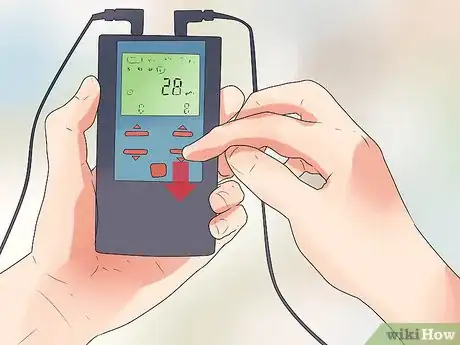
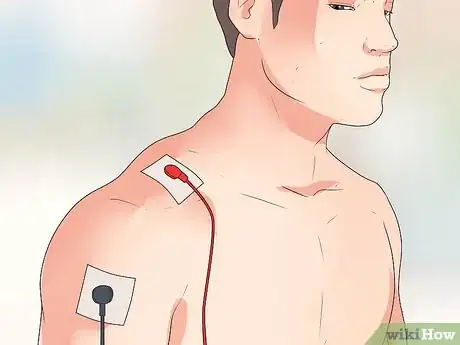
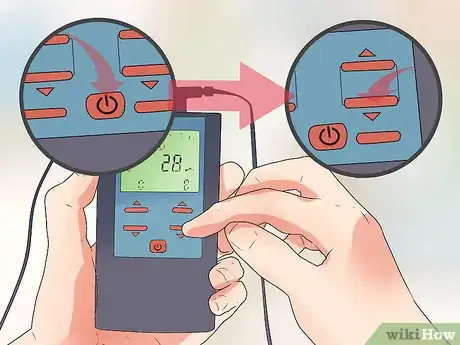
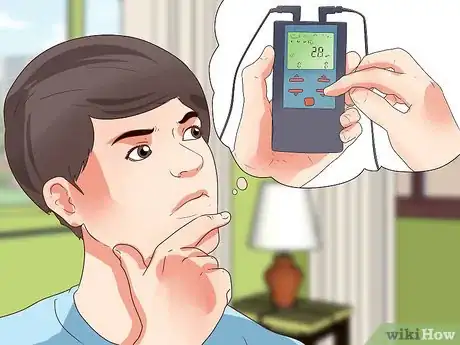
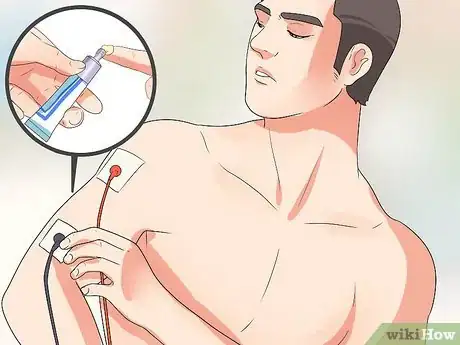
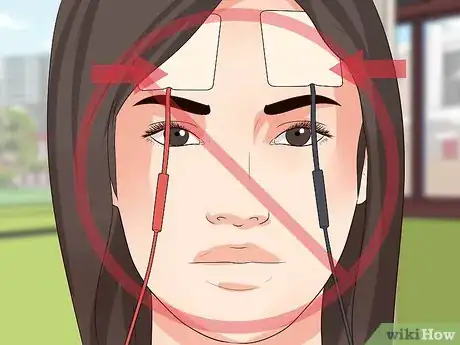
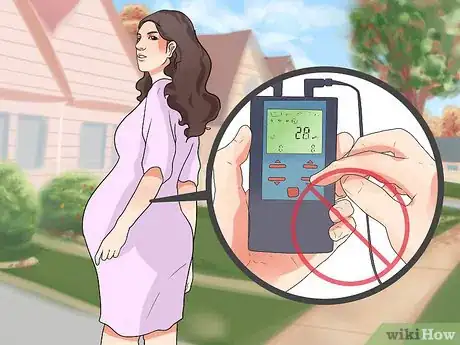
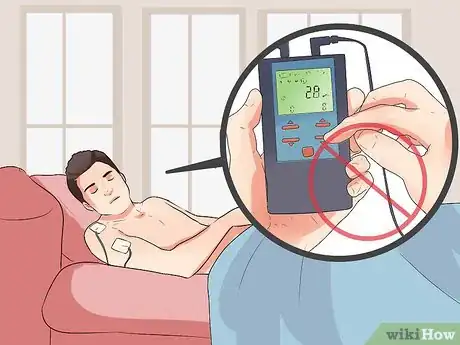


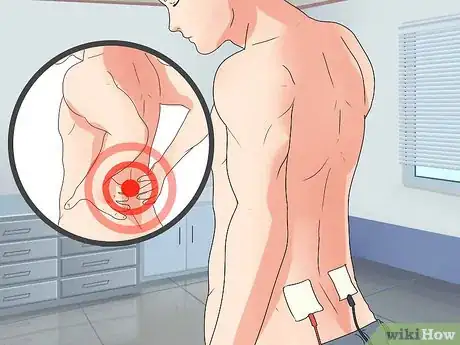
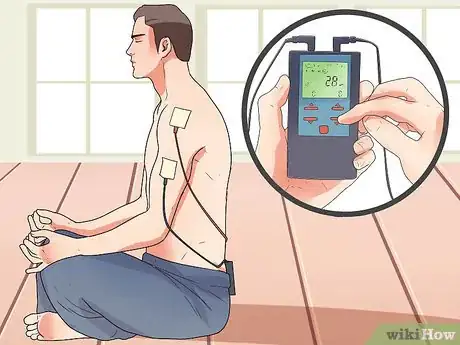


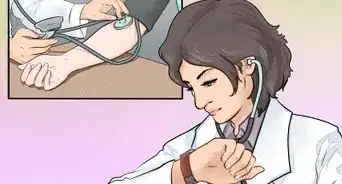



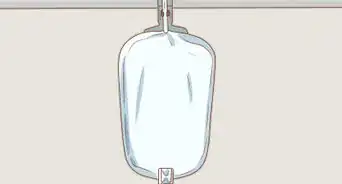


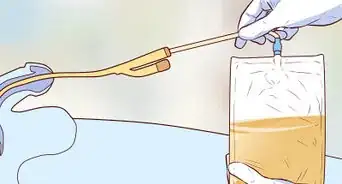
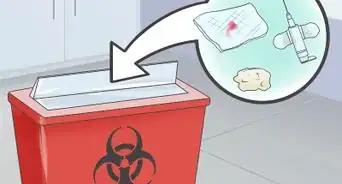








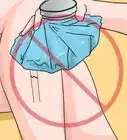

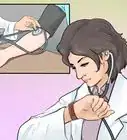




































Medical Disclaimer
The content of this article is not intended to be a substitute for professional medical advice, examination, diagnosis, or treatment. You should always contact your doctor or other qualified healthcare professional before starting, changing, or stopping any kind of health treatment.
Read More...